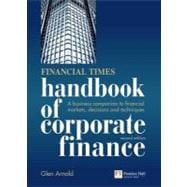
What is included with this book?
Glen Arnold is a businessman, investor and a professor of finance at Salford University. He’s the author of Corporate Financial Management, now in its fourth edition, Essentials of Corporate Financial Management, The Financial Times Guide to Value Investing, now in its second edition, and the market leading, The Financial Times Guide to Investing also in its second edition.
Table of Contents
CONTENTS
Introduction
· Some of the financial issues covered
· The scope of corporate finance
Chapter 1. What is the firm’s objective?
PART 1 – IINVESTING IN PROJECTS?
Chapter 2. State-of-the-art project assessment techniques
Chapter 3. Traditional appraisal techniques
Chapter 4. Investment decision-making in companies
Chapter 5. Allowing for risk in project appraisal
PART 2 SHAREHOLDER VALUE
Chapter 6. Value managed companies versus earnings managed companies
Chapter 7. Value through strategy
Chapter 8. Value creation within strategic business units
· Using cash flow to measure value
· Shareholder value analysis
· Economic profit
· Economic value added (EVA)
· Cash flow return on investment
Chapter 9. Entire firm value measurement
Chapter 10. What is the company’s cost of capital?
Chapter 11. Mergers: impulse, regret and success
Chapter 12. The merger process
Chapter 13. Valuing companies
Chapter 14. What pay-outs should we make to shareholders?
PART 3 – FINANCE RAISING
Chapter 15. Debt finance available to firms of all sizes
Chapter 16. Debt finance from the financial markets
Chapter 17. Raising equity capital
PART 4 – MANAGING RISK
Chapter 18. The financial risks managers have to deal with
Chapter 19. Options
Chapter 20. Using futures, forwards and swaps to manage risk
Chapter 21. Managing exchange rate risk
The New copy of this book will include any supplemental materials advertised. Please check the title of the book to determine if it should include any access cards, study guides, lab manuals, CDs, etc.
The Used, Rental and eBook copies of this book are not guaranteed to include any supplemental materials. Typically, only the book itself is included. This is true even if the title states it includes any access cards, study guides, lab manuals, CDs, etc.